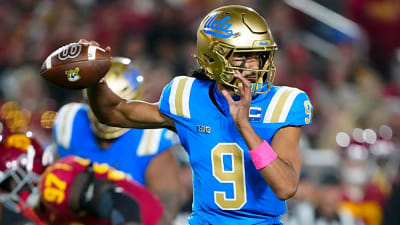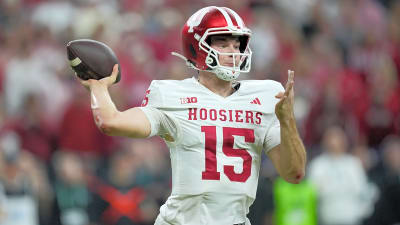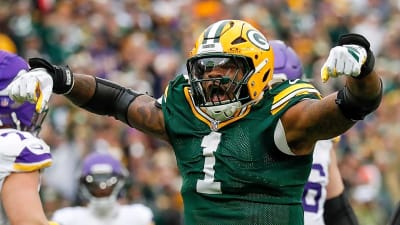- Home
- Quizzes
- My Quiz Activity
- Newsletters
- MY FAVORITES
- Add Sports/Teams
- SPORTS
-
NFL
- NFL Home
- Arizona Cardinals
- Atlanta Falcons
- Baltimore Ravens
- Buffalo Bills
- Carolina Panthers
- Chicago Bears
- Cincinnati Bengals
- Cleveland Browns
- Dallas Cowboys
- Denver Broncos
- Detroit Lions
- Green Bay Packers
- Houston Texans
- Indianapolis Colts
- Jacksonville Jaguars
- Kansas City Chiefs
- Las Vegas Raiders
- Los Angeles Chargers
- Los Angeles Rams
- Miami Dolphins
- Minnesota Vikings
- New England Patriots
- New Orleans Saints
- New York Jets
- New York Giants
- Philadelphia Eagles
- Pittsburgh Steelers
- San Francisco 49ers
- Seattle Seahawks
- Tampa Bay Buccaneers
- Tennessee Titans
- Washington Commanders
-
MLB
- MLB Home
- Athletics
- Arizona Diamondbacks
- Atlanta Braves
- Baltimore Orioles
- Boston Red Sox
- Chicago White Sox
- Chicago Cubs
- Cincinnati Reds
- Cleveland Guardians
- Colorado Rockies
- Detroit Tigers
- Houston Astros
- Kansas City Royals
- Los Angeles Angels
- Los Angeles Dodgers
- Miami Marlins
- Milwaukee Brewers
- Minnesota Twins
- New York Yankees
- New York Mets
- Philadelphia Phillies
- Pittsburgh Pirates
- San Diego Padres
- San Francisco Giants
- Seattle Mariners
- St. Louis Cardinals
- Tampa Bay Rays
- Texas Rangers
- Toronto Blue Jays
- Washington Nationals
-
NBA
- NBA Home
- Atlanta Hawks
- Boston Celtics
- Brooklyn Nets
- Charlotte Hornets
- Chicago Bulls
- Cleveland Cavaliers
- Dallas Mavericks
- Denver Nuggets
- Detroit Pistons
- Golden State Warriors
- Houston Rockets
- Indiana Pacers
- Los Angeles Clippers
- Los Angeles Lakers
- Memphis Grizzlies
- Miami Heat
- Milwaukee Bucks
- Minnesota Timberwolves
- New Orleans Pelicans
- New York Knicks
- Oklahoma City Thunder
- Orlando Magic
- Philadelphia 76ers
- Phoenix Suns
- Portland Trail Blazers
- Sacramento Kings
- San Antonio Spurs
- Toronto Raptors
- Utah Jazz
- Washington Wizards
-
NHL
- NHL Home
- Anaheim Ducks
- Boston Bruins
- Buffalo Sabres
- Calgary Flames
- Carolina Hurricanes
- Chicago Blackhawks
- Colorado Avalanche
- Columbus Blue Jackets
- Dallas Stars
- Detroit Red Wings
- Edmonton Oilers
- Florida Panthers
- Los Angeles Kings
- Minnesota Wild
- Montreal Canadiens
- Nashville Predators
- New Jersey Devils
- New York Islanders
- New York Rangers
- Ottawa Senators
- Philadelphia Flyers
- Pittsburgh Penguins
- San Jose Sharks
- Seattle Kraken
- St. Louis Blues
- Tampa Bay Lightning
- Toronto Maple Leafs
- Utah Mammoth
- Vancouver Canucks
- Vegas Golden Knights
- Washington Capitals
- Winnipeg Jets
- NCAAF
- NCAAM
- Olympics
- Boxing
- Entertainment
- Lifestyle
- Golf
- MMA
- Soccer
- Tennis
- Wrestling
- Sports Betting
- More Sports
- RESOURCES
- My Account
- YB on Facebook
- YB on Twitter
- YB on Flipboard
- Contact Us
- Privacy Policy
- Terms of Service

Best MLB player of all time drafted from every state
The MLB Draft isn't as publicized as the NFL and NBA Drafts, but it's just as important for building a successful organization. The following features the best MLB player drafted from all 50 states over the years.
Alabama: Frank Thomas, 1B

An alumnus of Auburn University, Thomas was selected seventh overall in the 1989 draft by the White Sox. He went on to have a Hall of Fame career, hitting .301 with 521 home runs and a .974 OPS for his career.
Alaska: Chad Bentz, RP
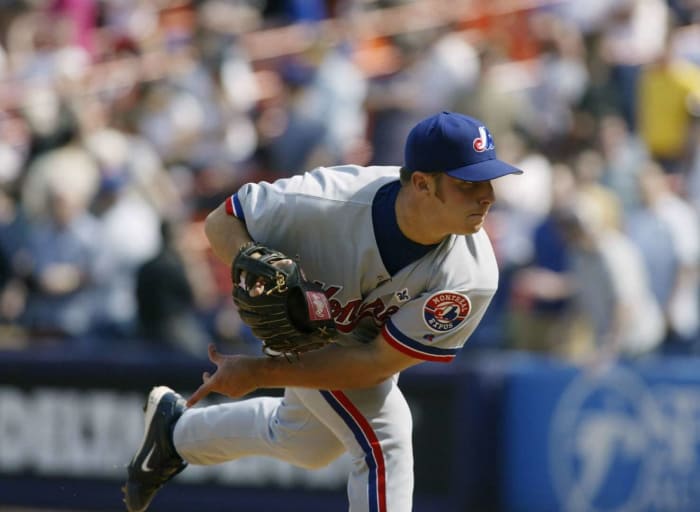
Bentz is the only player drafted out of the state of Alaska to appear in the majors. The lefty from Juneau High School appeared in 40 games over two seasons for the Montreal Expos and Florida Marlins in 2004-05. He was drafted in the 34th round in 1999 by the Yankees and then again in the seventh round of the 2001 draft by Montreal.
Arizona: Barry Bonds, OF

Bonds attended high school in California and was first drafted in the second round of the 1982 draft, but he then was drafted sixth overall in 1985 out of Arizona State. He's arguably the best hitter in baseball history with 14 All-Star appearances, seven MVP Awards and two batting titles. He's the all-time leader in home runs (762), walks (2,558) and single-season home runs (73).
Arkansas: Torii Hunter, OF

Graduating from Pine Bluff High School in Arkansas, Hunter was selected 20th overall by the Twins in 1993. He finished his career hitting .277 with 353 home runs and was a nine-time Gold Glove winner.
California: Rickey Henderson, OF

There's no absence of talent to come out of California, but Rickey Henderson is the best of the large group. The Hall of Famer won one MVP Award and made 10 All-Star appearances during his career. The greatest leadoff man of all time, he's the career leader in stolen bases (1,406) and runs scored (2,295), and he also reached the 3,000 hit mark. Henderson was drafted in the fourth round in 1976 out of Technical High School in Oakland by his hometown team.
Colorado: Roy Halladay, SP

Out of Arvada West High School, Halladay was taken 17th overall in 1995 by the Blue Jays. He had a great career, making eight All-Star appearances and winning two Cy Young Awards. He retired with 203 career wins and a 3.38 ERA.
Connecticut: Jeff Bagwell, 1B

A Hall of Fame first baseman, Bagwell is the best player to come from Connecticut by a wide margin. He attended the University of Hartford and was selected in the fourth round of the 1989 draft by the Red Sox. Bagwell spent his entire major league career with the Astros, hitting .297 with 449 home runs and a .948 OPS.
Delaware: Delino DeShields, 2B

DeShields had a productive career over 13 seasons and five organizations, hitting .268 with a .352 on-base percentage and 463 career stolen bases. He was selected 12th overall in 1987 by the Montreal Expos.
Florida: Alex Rodriguez, SS/3B

Rodriguez was selected first overall in 1993 by the Mariners out of Westminster Christian High School in Miami. He went on to be one of the best infielders of all time, winning three MVP Awards, 10 Silver Sluggers and two Gold Gloves. A-Rod retired with 696 career home runs and a .930 OPS.
Georgia: Kevin Brown, SP

Brown was one of the top starting pitchers in a hitter's era, winning two ERA titles and making six All-Star appearances. He retired with 211 wins and a 3.28 ERA. Brown was drafted fourth overall by the Rangers in 1986 out of Georgia Tech.
Hawaii: Sid Fernandez, SP

Fernandez edges Shane Victorino as the best Hawaiian baseball player ever drafted. Selected in the third round of the 1981 draft by the Dodgers, the lefty had a 15-year career with 114 wins and 3.36 ERA, mostly with the Mets.
Idaho: Keith Foulke, RP

Foulke is often remembered as the closer of the 2004 Boston Red Sox. He's one of many impressive baseball players to come out of Lewis-Clark State College in Lewiston, Idaho. Foulke had 191 career saves after being drafted in the ninth round by the Giants in 1994. He was also previously drafted by the Detroit Tigers in the 14th round in 1993.
Illinois: Jim Thome, 1B

Graduating from Illinois Central College in Peoria, Thome was selected in the 13th round of the 1989 draft by Cleveland. A five-time All-Star, Thome retired with 612 career home runs and a .402 on-base percentage, earning a place in the Hall of Fame.
Indiana: Scott Rolen, 3B

Rolen was a second-round pick in 1993 by Philadelphia out of Jasper High School. He has borderline Hall of Fame credentials with seven All-Star appearances, eight Gold Gloves and one Silver Slugger. He retired with 316 career home runs and an .855 OPS.
Iowa: Jim Sundberg, C

Sundberg was drafted two years in a row by the Rangers — and previously by the A's — finally signing in 1973 after being selected second overall in the secondary phase. An alumnus of Iowa, Sundberg made three All-Star appearances and won six Gold Gloves during his 16-year career.
Kansas: Davey Lopes, OF

Coming out of Washburn University in Topeka, Lopes was selected in the second round of the secondary phase of the 1968 draft by the Dodgers. He had a solid career with four All-Star appearances, one Gold Glove and 557 stolen bases. Lopes was also previously drafted by the Giants in the eighth round of the 1967 draft.
Kentucky: David Justice, OF

Justice was a three-time All-Star and two-time Silver Slugger Award winner during his 14-year career. He was selected in the fourth round of the 1985 draft by Atlanta out of Thomas More College. Justice retired with an .878 OPS and 305 home runs.
Louisiana: Chuck Finley, SP

Finley was drafted twice by the Angles, first in the 15th round in 1984 and then in the first round out of Louisiana-Monroe in the 1985 secondary draft. He made five All-Star appearances during his career, finishing with exactly 200 wins and a 3.85 ERA.
Maine: Bill Swift, SP

Swift played 13 MLB seasons, winning the NL ERA title in 1992 with the Giants. He had a career 3.95 ERA over 403 appearances, including 220 starts. He was selected second overall in the 1984 draft out of Maine by the Mariners after first getting selected by the Twins in the second round in 1983.
Maryland: Cal Ripken, SS/3B

Ripken played baseball at Aberden High School in Maryland and was selected in the second round by the Orioles in 1978. His Hall of Fame accomplishments include two MVPs, 19 All-Star appearances, eight Silver Sluggers, two Gold Gloves and the consecutive games played record.
Massachusetts: Tom Glavine, SP

Glavine was selected in the second round of the 1984 draft by the Braves out of Billerica High School in Massachusetts. The Hall of Fame lefty won two Cy Young Awards and also made 10 All-Star appearances. He retired with 305 wins and a 3.54 ERA.
Michigan: Derek Jeter, SS

Jeter edges fellow shortstop Barry Larkin as the best player drafted from the state of Michigan. The Captain was selected sixth overall in 1992 out of Central High School in Kalamazoo by the Yankees. A surefire Hall of Famer, Jeter won five World Series in New York and made 14 All-Star appearances. He's also a member of the 3,000 hit club.
Minnesota: Paul Molitor, 3B/2B/1B

The current manager of the Twins, Molitor had a Hall of Fame career with seven All-Star appearances, four Silver Sluggers and 3,319 hits over 21 seasons. He was selected third overall by the Brewers in 1977 out of the University of Minnesota. The Cardinals previously drafted Molitor in the 1974 draft.
Mississippi: Rafael Palmeiro, 1B

First drafted in the eighth round of the 1982 draft by the Mets, Palmeiro had a terrific major league career after being selected 22nd overall by the Cubs out of Mississippi State in 1985. He won three Gold Gloves and two Silver Sluggers and has Hall of Fame stats with 3,020 hits and 569 home runs. Unfortunately, his prospects for the Hall of Fame seem bleak after a PED suspension late in his career.
Missouri: Albert Pujols, 1B

Pujols grew up in the Dominican Republic before coming to the Kansas City area in high school. He attended Maple Woods Community College in K.C. and was selected by the Cardinals in the 13th round of the 1999 draft. Arguably the best hitter of his era, Pujols won three MVPs and six Silver Sluggers in St. Louis. Now with the Angles, Pujols has more than 600 home runs and 3,000 hits.
Montana: Les Rohr, P

Only three players drafted from Montana have reached the majors. Rohr was easily the highest draft pick, selected second overall in 1965 by the Mets out of Billings West High School. He made six appearances over four seasons with a 3.70 ERA in 24.1 innings.
Nebraska: Alex Gordon, 3B

The University of Nebraska has produced a long line of productive major leaguers, with Gordon leading the way. The second overall pick by the Royals in 2005, Gordon has had an up and down career, but he does have three All-Star appearances, five Gold Gloves and more than 160 career home runs.
Nevada: Greg Maddux, SP

While Bryce Harper is well on his way to becoming one of Nevada's greatest ballplayers, Maddux is well-established as the best player from the state, drafted in the second round of the 1984 draft out of Valley High School in Vegas. The Hall of Famer won four Cy Young Awards and made eight All-Star appearances. Remarkably, he also won 18 Gold Gloves. Maddux retired after the 2008 season with 355 wins and a 3.16 ERA.
New Hampshire: Chris Carpenter, SP

The 15th overall pick in 1993 out of Trinity High School in Manchester, N.H., Carpenter was drafted by the Blue Jays but had his greatest success with the Cardinals. He won the NL Cy Young in 2005 and finished in the top three in voting three times, retiring with a career 3.76 ERA over 15 seasons.
New Jersey: Mike Trout, OF

Craig Biggio is the only Hall of Fame ballplayer drafted out of New Jersey, but Trout will almost certainly join him one day. Drafted 25th overall by the Angels out of Millville Senior High School, Trout has already won two MVP Awards and has had arguably the greatest start to a career in MLB history.
New Mexico: Tony Phillips, OF/2B
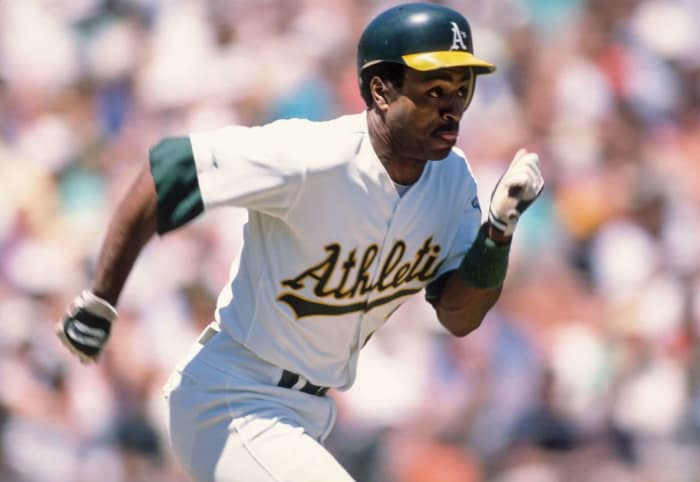
Phillips was the 10th overall selection by the Expos in the 1978 secondary draft. An alumnus of New Mexico Military Institute, Phillips had a productive 18-year career with more than 2,000 hits and a career .374 on-base percentage. He was originally drafted in the 16th round of the 1977 draft by the Mariners.
New York: Manny Ramirez, OF

Ramirez was the 13th overall pick in the 1991 draft by the Indians out of George Washington High School in New York City. He was one of the best hitters of his era, hitting 555 home runs with a .996 OPS over his 19-year career. Ramirez made 12 All-Star appearances and won one batting title.
North Carolina: Madison Bumgarner, SP

The Giants took Bumgarner 10th overall in the 2007 draft out of South Caldwell High School in Hudson, N.C. He's helped them win three World Series, making four All-Star appearances and finishing top six in the AL Cy Young voting three times.
North Dakota: Darin Erstad, OF

Erstad was selected in the 13th round of the 1992 draft by the Mets out of Jamestown High School but elected to attend college at Nebraska instead of signing. It was a smart decision, as he ascended to the first overall pick in the 1995 draft. Erstad had a career .282 batting average and 124 home runs over 14 seasons.
Ohio: Mike Schmidt, 3B

The Phillies took Schmidt in the second round in 1971 out of Ohio University. He rewarded them with a Hall of Fame career, winning three MVPs and 10 Gold Gloves. He led the NL in home runs eight times and retired with 548 home runs and a .908 OPS.
Oklahoma: Johnny Bench, C

The Reds selected Bench in the second round of the 1965 draft out of Binger High School. He had a Hall of Fame career with the Reds, winning two MVP Awards, 10 Gold Gloves and two World Series. Recognized as one of the greatest catchers ever, Bench had 389 career home runs.
Oregon: Dale Murphy, OF

A two-time MVP, Murphy was selected fifth overall by the Braves in 1974 out of Woodrow Wilson High School in Portland. He also won five Gold Gloves and four Silver Sluggers.
Pennsylvania: Mike Mussina, SP

Mussina was selected in the 11th round of the 1987 draft by the Orioles out of Montoursville High School, but he attended Stanford instead. Baltimore was able to get him three years later at a much greater cost with the 20th overall pick. Mussina is a fringe Hall of Fame candidate with 270 wins and a 3.68 ERA over 18 seasons.
Rhode Island: Jerry Remy, 2B

Best known now as a Red Sox broadcaster, Remy played 10 major league seasons for the Angels and Red Sox. He was an eighth-round pick in the 1971 draft in the January Draft-Secondary Phase out of Roger Williams University. Remy hit .275 with 208 stolen bases for his career, making one All-Star appearance. The Washington Senators first drafted him late in the 1970 draft.
South Carolina: Jimmy Key, SP

Key edges Jim Rice as the best player drafted out of South Carolina. The Clemson alumnus was a third-round pick by Toronto in 1982. Over 15 seasons, Key made four All-Star appearances and won the AL ERA title in 1987. He retired with 186 wins and a 3.51 ERA. The White Sox were the first team to draft Key in 1979, selecting him in the 10th round, but Key opted to head to Clemson instead of signing.
South Dakota: Dave Collins, OF

Collins failed to sign in 1971 after the Royals took him in the 23rd round out of Stevens High School in Rapid City, S.D. He signed the year after the Angels took him sixth overall in the secondary phase after one season at Mesa Community College in Arizona. He played 16 seasons in the majors, hitting .272 with 395 stolen bases.
Tennessee: Todd Helton, 1B

Helton played both baseball and football at Tennessee but gave way to Peyton Manning at quarterback. The Rockies selected him eighth overall in 1995, and he became their best player to date. Helton made five All-Star appearances and won four Silver Sluggers and three Gold Gloves in his 17 years with the Rockies. He retired with a .316 batting average and .953 OPS. The Padres first selected Helton in 1992 in the second round before Helton decided to head to Tennessee.
Texas: Roger Clemens, SP

Clemens has been penalized by Hall of Fame voters for his rumored connection to PEDs, but he's clearly one of the best pitchers in history. The right-hander won a whopping seven Cy Young Awards and one MVP in his 24-year career. He retired with 354 wins, a 3.12 ERA and 4,672 strikeouts. Clemens was drafted 19th overall by the Red Sox in 1983 out of the University of Texas. Before heading to Texas, the Mets took in the 12th round in 1981.
Utah: Jack Morris, SP

An alumnus of BYU, Morris was a fifth-round pick by the Tigers in 1976. He won three World Series during his career and made five All-Star appearances, finishing with 254 wins and a 3.90 ERA.
Vermont: Kirk McCaskill, P

McCaskill is the only baseball player drafted from the state of Vermont to appear in the majors. The Vermont alumnus was taken in the fourth round of the 1982 draft by the Angels. He played 12 seasons in the majors, winning 106 games with a 4.12 ERA.
Virginia: Lou Whitaker, 2B

Whitaker was selected in the fifth round of the 1975 draft by Detroit out of Martinsville High School. He had a great career with five All-Star appearances, four Silver Sluggers and three Gold Gloves. The second baseman had a .789 career OPS and 244 home runs.
Washington: Ryne Sandberg, 2B

The Phillies selected Sandberg in the 20th round of the 1978 draft out of North Central High School in Spokane. He would later become their manager following his Hall of Fame playing career. He won one MVP and made 10 All-Star appearances with the Cubs. Sandberg also won nine Gold Gloves and seven Silver Sluggers.
West Virginia: Joe Niekro, SP

Niekro was drafted by the Cubs in the third round of the January Draft-Secondary Phase in 1966 out West Liberty State College. He played 22 seasons and won 221 games with a 3.59 ERA. The Indians took him in the seventh round in 1996 before Niekro decided to go to college.
Wisconsin: Jarrod Washburn, SP

A second-round pick by the Angels in 1995 out of Wisconsin-Oshkosh, Washburn played 12 MLB seasons. He retired with 107 wins and a 4.10 ERA following the 2009 season.
Seth Trachtman is a sportswriter, digital marketer, and fantasy sports expert based in St. Louis, Missouri. He’s a two-time winner of the Tout Wars Fantasy Baseball Expert’s League, and his work has appeared in hundreds of fantasy baseball and fantasy football newsstand and online publications
More must-reads:
- First-round 2018 MLB Mock Draft
- The best first overall MLB Draft picks ever
- The 'NFL's active 300-yard passers' quiz
Customize Your Newsletter
 +
+
Get the latest news and rumors, customized to your favorite sports and teams. Emailed daily. Always free!
PRIVACY POLICY EDITORIAL POLICY CONTACT US
ABOUT YARDBARKER TERMS OF SERVICE
Use of this website (including any and all parts and
components) constitutes your acceptance of these
Terms of Service and Privacy Policy.
This site is for entertainment purposes only.
There is no gambling offered on this site.
Gambling Problem? Call 1-800-Gambler.

